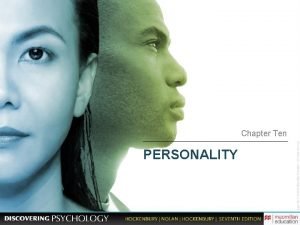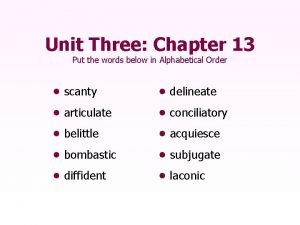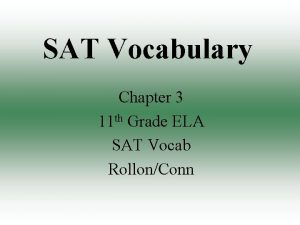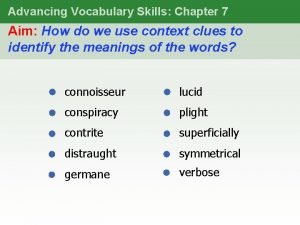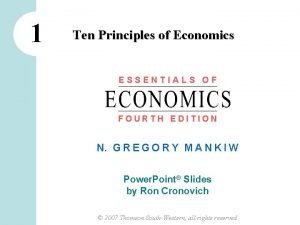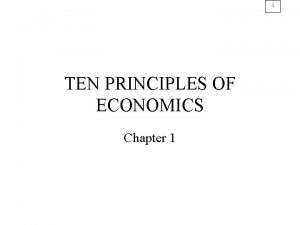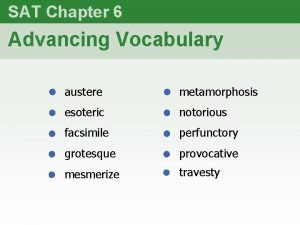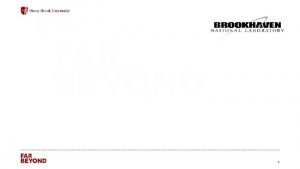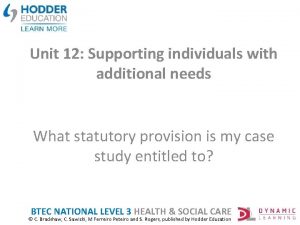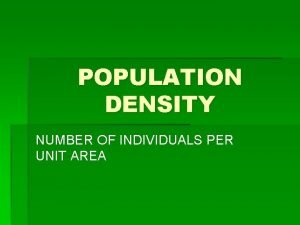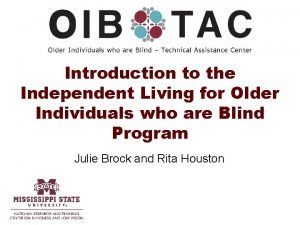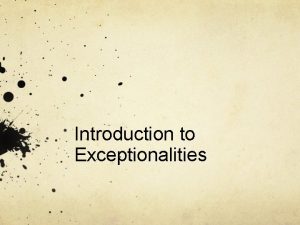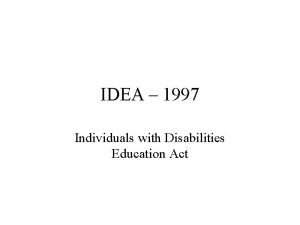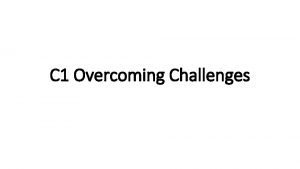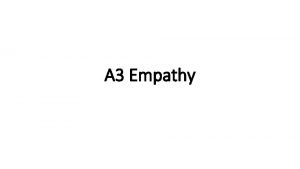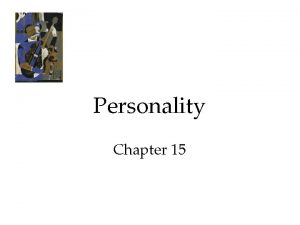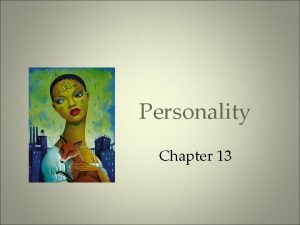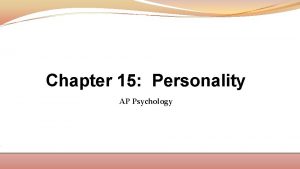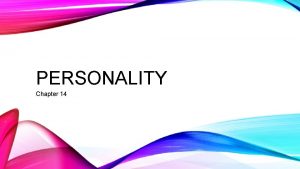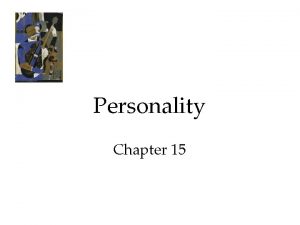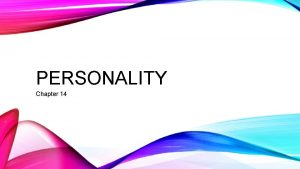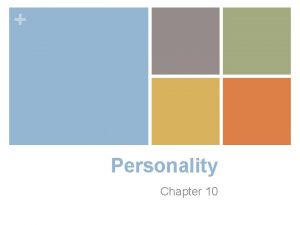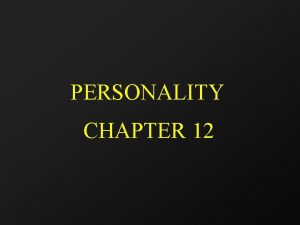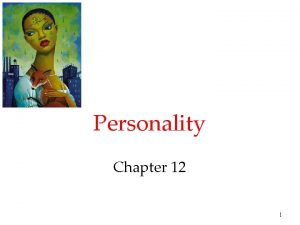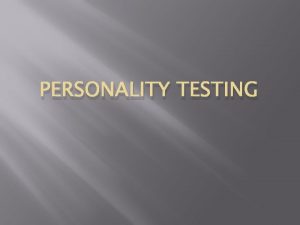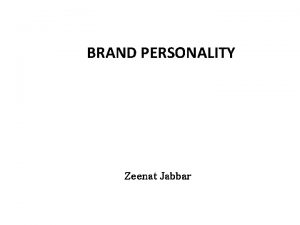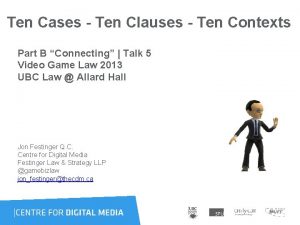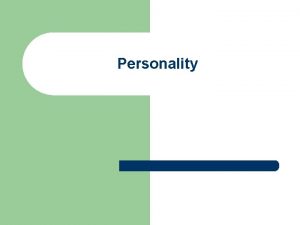Chapter Ten PERSONALITY Personality Refers to an individuals




































- Slides: 36

Chapter Ten PERSONALITY


Personality: Refers to an individual’s unique and relatively consistent pattern of thinking, feeling, and behaving Personality theory: Describes and explains how people are similar, how they are different, and why every individual is unique


What Is Personality? • Four major theoretical perspectives on personality – – Psychoanalytic perspective Humanistic perspective Social cognitive perspective Trait perspective

Psychoanalytic Perspective on Personality Freud • Influenced by Joseph Breuer; used hypnosis; treated patients with psychological symptoms; used free association • Asserted sexuality was fundamental human motive and aggression was second powerful human instinct • Created important works

Freud’s Dynamic Theory of Personality: Psychoanalytic Approach • Psychoanalysis is both an approach to therapy and a theory of personality. • Emphasized unconscious motivation: main causes of behavior lie buried in the unconscious mind • Saw personality and behavior as the result of a constant interplay among conflicting psychological forces • Psychological forces operate at three different levels of awareness: • Conscious • Preconscious • Unconscious

Levels of Awareness and the Structure of Personality

Techniques to Reveal the Unconscious • Free association • A psychoanalytical technique in which the patient spontaneously reports all thoughts, feelings, and mental images as they come to mind • Dream analysis – Content of dreams – Manifest content (surface meaning) – Latent content (true, unconscious meaning)

The Structure of Personality Id • Instinctual drives present at birth • Does not distinguish reality from fantasy • Operates according to pleasure principle – Motive is to obtain pleasure and avoid tension or discomfort; this is the most fundamental human motive and guiding principle of id – Immune to logic Energy comes from • Eros: Self-preservation or life instinct • Libido: Psychological and emotional energy associated with expressions of sexuality; sex drive • Thanatos: Death instinct – Reflected in aggressive, destructive, and selfdestructive actions

The Structure of Personality Ego • Is partly conscious rational component of personality that develops out of the id in infancy • Understands reality and logic • Is most in touch with the demands of the external world • Acts as mediator between id and superego Reality principle • Is ability to postpone gratification in accordance with demands of external world • Can repress desires that cannot be met in an acceptable manner

The Structure of Personality Superego • At age 5 or 6, child develops an internal, parental voice that is partly conscious • Internalization of parental and society’s moral standards • Responsible for guilt; it praises and admonishes Establishing the Superego

The Ego Defense Mechanisms: Unconscious Self-Deceptions • If a realistic solution or compromise is not possible, the ego may temporarily reduce anxiety by distorting thoughts or perceptions of reality through defense mechanisms. – – – – – Repression Displacement Sublimation Rationalization Projection Reaction formation Denial Undoing Regression


Personality Development • Freud’s psychosexual stages – People progress through five psychosexual stages of development. • Oral, and phallic, latency, and genital stages – Each psychosexual stage represents a different focus of the id’s sexual energies; and each is age-related and focused on different bodily zones.

Personality Development • Fixation – At each psychosexual stage, the child is faced with a developmental conflict that must be successfully resolved. – Child may be frustrated or overindulged in that stage’s expression of pleasurable feelings. – In either case, the result of an unresolved developmental conflict is fixation.

The Oedipus Complex: A Psychosexual Drama Child’s unconscious sexual desire for the opposite-sex parent; usually accompanied by hostile feelings toward the same-sex parent. Boys Girls • Confrontation with father for the affections of mother • Boy feels hostility and jealousy toward his father • Realizes that father is more physically powerful • Boy experiences castration anxiety, or fear that father will castrate him • To resolve, boy uses identification — imitates and internalizes father’s values, attitudes, mannerisms • Little girl discovers that little boys have a penis and that she does not • Feels a sense of deprivation and loss — penis envy • Attempts to take her mother’s place with her father, she also identifies with her mother • One of the most critiqued of Freud’s ideas • Freud admitted “the sexual life of adult women is a ‘dark continent’ for psychology. ”

Latency and Genital Stages • Latency (5 years–puberty) • • Because the Oedipus complex causes anxiety, the sexual urges of boys and girls become repressed Children desire to associate with same-sex peers, a preference that strengthens the child’s sexual identity – Genital Stage (puberty and older) – Final resolution of the Oedipus complex in adolescence – Incestuous urges start to resurface; they are prohibited by superego and societal restriction – Person directs sexual urges toward socially acceptable substitutes, who often resemble the person’s opposite-sex parent

The Humanistic Perspective on Personality • Humanism – Emphasizes free will, self-awareness, and psychological growth – Emphasizes inherent goodness of people, human potential, self-actualization, self-concept, and healthy personality development

Unconditional Positive Regard • Rogers contended that healthy personality development is the result of being unconditionally valued and loved as a person. • He advised parents and teachers to control a child’s inappropriate behavior without rejecting the child himself. • Such a style of discipline teaches acceptable behaviors without diminishing the child’s sense of self-worth.

The Social Cognitive Perspective on Personality • Social cognitive perspective – Emphasizes conscious, self-regulated behavior rather than unconscious mental influences and instinctual drives – Stresses conscious thought processes, self-regulation, and the importance of situational influences – Proposes that sense of self can vary, depending on thoughts, feelings, and behaviors in a given situation • Social cognitive personality theorists – Rely on experimental findings

Trait Perspective on Personality • Trait: Formally defined as relatively stable, enduring predisposition to behave in a certain way • Trait theorists: Focus on identifying, describing, and measuring individual differences in behavioral predispositions • Trait theorists view the person as being a unique combination of personality characteristics or attributes, called traits

Surface Traits and Source Traits • Surface trait – Characteristics or attributes that can be inferred from observable behavior – 4, 000 English words describe specific personality traits (Allport and Odbert) • Source trait – Most fundamental dimensions of personality; broad, basic traits that are hypothesized to be universal and relatively few in number

Neuroscience of Personality: Brain Structure and the Big Five Extraversion Agreeableness Conscientiousness • Medial orbitofrontal cortex • Being sensitive to rewarding stimuli • Posterior cingulate cortex • Understanding beliefs of others • Fusiform gyrus • Perceiving faces • Middle frontal gyrus • Involved in planning, working memory, and self-regulation Neuroticism Openness to experience • Mixed pattern of brain structure • No significant pattern of brain differences


Assessing Personality • Psychological tests: Assess a person’s abilities, aptitudes, interests, or personality on the basis of a systematically obtained sample of behavior • Any psychological test is useful insofar as it achieves two basic goals: – It accurately and consistently reflects a person’s characteristics on some dimension. – It predicts a person’s future psychological functioning or behavior.

Projective Tests • Rorschach Inkblot Test: Projective test using inkblots, developed by Swiss psychiatrist Hermann Rorschach in 1921 What Do You See in the Inkblot?

Projective Tests • Thematic apperception test (TAT): A projective personality test, developed by Henry Murray and colleagues, that involves creating stories about ambiguous scenes • The person is thought to project his own motives, conflicts, and other personality characteristics into the story he creates. Thematic Apperception Test Involves creating a story about a highly evocative, ambiguous scene, like the ones shown in the cards in the photograph above.

Self-Report Inventories • Minnesota Multiphasic Personality Inventory (MMPI): A self-report inventory that assesses personality characteristics and psychological disorders; used to assess both normal and disturbed populations • California Psychological Inventory (CPI): A self-report inventory that assesses personality characteristics in normal populations • Sixteen Personality Factor Questionnaire (16 PF): A self-report inventory developed by Raymond Cattell that generates a personality profile with ratings on 16 trait dimensions

Strengths and Limitations of Self-Report Inventories • Most important strengths of self-report inventories – Are standardized – Use established norms – Reliability and validity greater than those of projective tests • Self-inventory weaknesses – – Takers may “fake” responses to look better (or worse) High number of items leads to loss of interest Takers not always accurate in self-judgments No personality test, by itself, is likely to provide a definitive description of any given individual

Self-Report Inventories • Myers-Briggs Type Indicator (MBTI): Selfreport personality test that involves categorizing personality types • Test measures person’s preferred way of dealing with information, making decisions, and interacting with others. • Psychologists urge caution in using and interpreting findings.




Final work: Psychological characteristic • • Psychological study (of your-self) Use psychological tests to examine personality The general parameters are outlined Term: April, 26 - May, 3

 It's twenty to eight
It's twenty to eight Ten ten siempre fuerzas y esperanza
Ten ten siempre fuerzas y esperanza Ten ten program
Ten ten program A trait is formally defined as a(n)
A trait is formally defined as a(n) Chapter 13 ten words in context
Chapter 13 ten words in context Complete the review with the words below check out
Complete the review with the words below check out What are the essentials of a successful ffa chapter
What are the essentials of a successful ffa chapter Chapter 16 ten words in context
Chapter 16 ten words in context Chapter 13 ten words in context sentence check 2 answers
Chapter 13 ten words in context sentence check 2 answers Chapter 25 ten words in context
Chapter 25 ten words in context Chapter 23 sentence check 2 answers
Chapter 23 sentence check 2 answers Sentence check 2 chapter 12
Sentence check 2 chapter 12 Chapter 10 ten words in context answer key
Chapter 10 ten words in context answer key Ten words in context chapter 3
Ten words in context chapter 3 Ten words in context chapter 2
Ten words in context chapter 2 One of the ten principles of economics in chapter 1
One of the ten principles of economics in chapter 1 Chapter 6 sentence check 1
Chapter 6 sentence check 1 Chapter 7 ten words in context
Chapter 7 ten words in context One of the ten principles of economics in chapter 1
One of the ten principles of economics in chapter 1 Ten principles of economics chapter 1
Ten principles of economics chapter 1 Chapter 18 adjustments and the ten-column worksheet answers
Chapter 18 adjustments and the ten-column worksheet answers Chapter 6 ten words in context
Chapter 6 ten words in context What are the ten essentials of a successful ffa chapter
What are the ten essentials of a successful ffa chapter Supporting individuals with additional needs
Supporting individuals with additional needs Photo/drawing of individuals/groups/institutions
Photo/drawing of individuals/groups/institutions Risk management for enterprises and individuals
Risk management for enterprises and individuals Individuals don't evolve populations do
Individuals don't evolve populations do Number of individuals per unit area
Number of individuals per unit area Individuals: an essay in descriptive metaphysics
Individuals: an essay in descriptive metaphysics Older individuals who are blind program
Older individuals who are blind program Individuals with exceptionalities
Individuals with exceptionalities Marcia erikson
Marcia erikson Idea 97
Idea 97 Impact of not enabling individuals to overcome challenges
Impact of not enabling individuals to overcome challenges Empathy theories johannes volkelt
Empathy theories johannes volkelt Turning individuals into team players
Turning individuals into team players Individuals
Individuals



